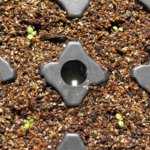Re: Leverhead's 2013 T Patches
Back on topic again. I wasn't very happy with the starter trays I had last year they were only a little over 2" deep, 72 cells. This year I got a case of Item # 720580C at
http://www.amleo.com/to-plastics-star-plug-tray/p/VP-TO-STAR/.
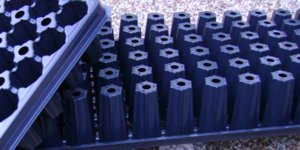
They're still 72 cell, but the cells are 3" deep. 50 will probably last me the rest of my life, I'm pleased with these for now, they're well made. If the roots ball up at the bottom they'll be an inch deeper than last year.
The seed start was in a plastic tub on peat, I posted a picture on 2-11-13. If you notice the finger marks on the surface of the peat, that's where I patted down the peat. It's a bad idea, ignore it. Just drop the container on a firm surface from an inch or so. The roots had a hard time working into the surface. I fed them water for a week and then started spraying them with grow juice.
I am growing a Flue Cured type tobacco and used this guide for how much of what to put in the water. If you're growing a flue-cure variety, save a copy of it.
http://ipm.ncsu.edu/Production_Guides/Flue-Cured/flue_cured.pdf
The amounts were small, so I used a reloading scale with units in Grains and figured everything in Gr (Grains) per Gallon of water. The materials I used were pretty off the wall, but the recipe worked well for me. I didn't want too much Urea in the water, that would kill the seedlings.
13.6 Gr Miracle-Gro 18-18-21
12.7 Gr Grant's stump remover (Potassium Nitrate 13-0-46)
8.8 Gr Ammonium Nitrate (From instant cold packs)
17.5 Gr Epsom salts
1.1 Gr Borax
The wick system I copied from one of the big (rip off) seed companies is pretty simple and it works well for me. It has the pluses of even moisture supply from the bottom and having all the nutrients in the water, easy to measure and correct. The biggest problem seems to be keeping the bottom trays leak free, the bottom corners leave the plastic stretched pretty thin. A quick disassembly to add a piece of plastic sheet fixed it, until I can find better bottom trays the plastic sheet may become a standard part.
The parts are pretty straight forward, bottom tray (plastic sheet not shown), eight plastic bottle caps, plastic sign material, "Fiber-fill" non woven mat and a top cover/wick.
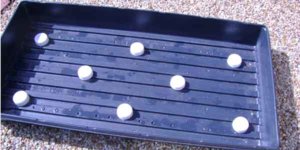
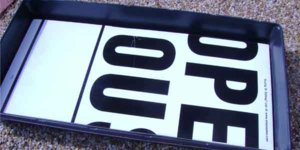
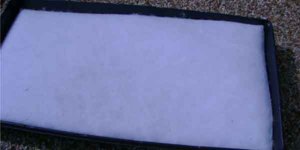
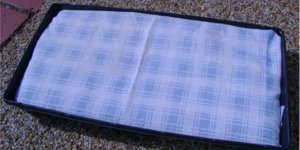
The bottle caps are just stand offs, as long as they're all the same height they're good. They support the sign material leaving a space for the water/fertilizer mix. The sign material is an extruded plastic, in section it looks like corrugated cardboard. It's cut to support the mat, cover and the bottom of the starter tray. There should be 1/4 inch or more clearance all the way around between it and the bottom tray. The mat is a non woven man-made fiber, cut the same size as the sign material. The stuff I had is over an inch thick, I don't think it has to be that thick or multiple layers of thinner material should do. A fabric store should be a good source for a filler for quilts. The mat serves two functions, It acts as a wick across the bottom of the starter tray and it's springy enough to stay in contact with all the bottoms of the cells. The top cover needs to be a fine enough weave to keep the peat/vermiculite mix out of the mat, cut large enough to reach down to the bottom of the bottom tray. It wicks the water mix up to the mat.
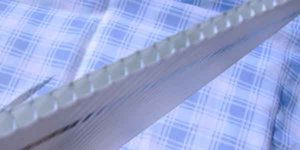
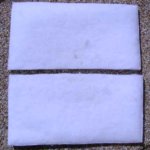
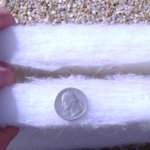
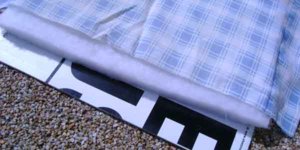
I used a 50/50 mix of peat/vermiculite to fill the trays, with enough water added to just make a ball when squeezed. I put some of the sign material underneath the starter tray to keep the mix from falling out of bottom holes. I filled all the cells loosely with the mix and settled it by dropping the sign and tray an inch or so, a couple of times. Refill if necessary and resettle, scrape the top off level. Lift the tray up high enough to check that the mix went to the bottom of all the cells and didn't fall out, if it keeps falling out add some more water to the mix.
I put a little over a gallon of water/fertilizer mix in the bottom tray, about up to the bottom of the sign material and set the filled starter tray on top. Leave it for a few hours to let the water mix moisten the cells, then add seedlings to taste. I use a pencil to make little holes in the middle of the cells and wet the point a little to pick up the seedlings once the roots start to branch. I pull in enough peat mix to keep the seedling in place and when I'm done with the tray I "spray them in" with water in a spray bottle.
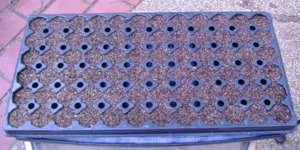
After adding water/fertilizer mix at start up, I only add water to make up for evaporation. At four weeks I'll add 15.7 Gr/Gal of Ammonium Nitrate, about 16 Gr per tray and keep making up for evaporation with water. I didn't let them dry out before transplant last year and they were a little too wet to handle well. This year I'm going to dry them out a little bit, I'll update then.












